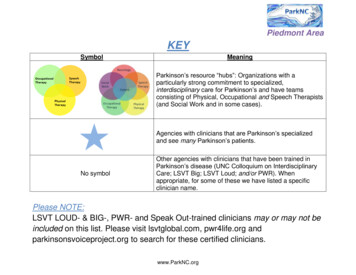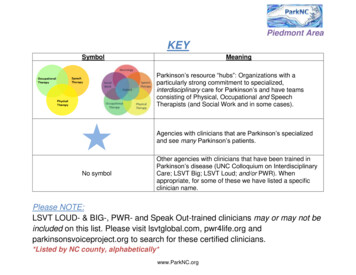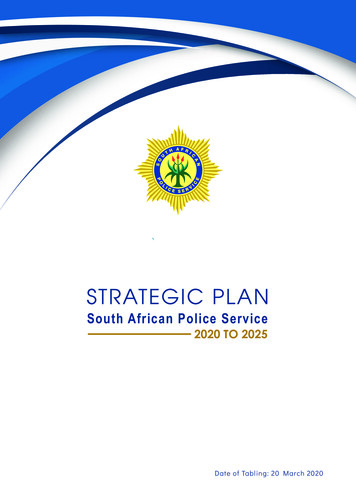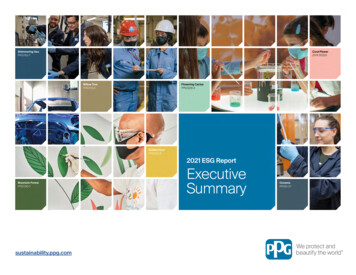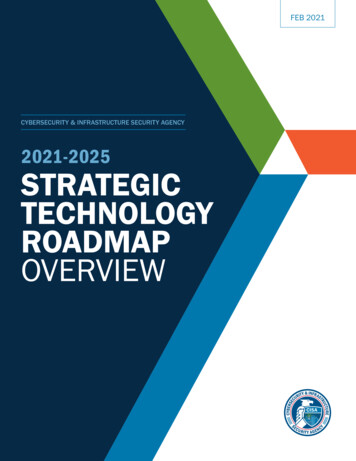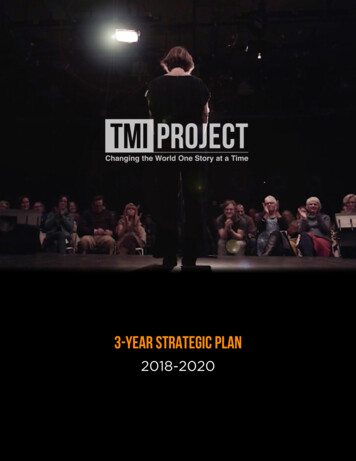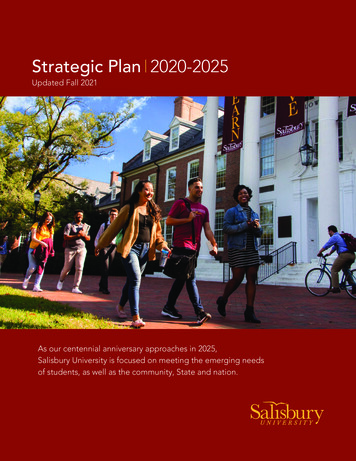
Transcription
Strategic Plan 2020-2025Updated Fall 2021As our centennial anniversary approaches in 2025,Salisbury University is focused on meeting the emerging needsof students, as well as the community, State and nation.
MISSIONVALUESSalisbury University is a premier comprehensiveMaryland public university offering excellent,affordable education in undergraduate liberal arts,sciences, business, nursing, health sciences, socialwork and education, and applied master’s anddoctoral programs. Our highest purpose is toempower our students with the knowledge, skillsand core values that contribute to activecitizenship, gainful employment, and life-longlearning in a democratic society andinterdependent world.Salisbury University cultivates and sustains asuperior learning community where students,faculty and staff are viewed as learners,teachers/scholars and facilitators, and where acommitment to excellence and openness to abroad array of ideas and perspectives are central toall aspects of University life. Our learningcommunity is student-centered. Students learnfrom professional educators in small classroomsettings, faculty and professional staff serve asacademic advisors, and virtually every student hasan opportunity to undertake research orexperiential learning with a faculty mentor. Throughour four privately endowed Schools, the College ofHealth and Human Services, and the HonorsCollege, we foster an environment whereindividuals prepare for career and life, includingtheir social, physical, occupational, emotional andintellectual well-being.The University recruits exceptional and diversefaculty, staff, and undergraduate and graduatestudents from across Maryland and the UnitedStates and from around the world, supporting allmembers of the University community as they worktogether to achieve institutional goals and vision.Believing that learning and service are vitalcomponents of civic life, Salisbury Universityactively contributes to the local Eastern Shorecommunity and the educational, economic,cultural, and social needs of our State and nation.The core values of Salisbury University areexcellence, student centeredness, learning,community, civic engagement, and diversity andinclusion. We believe these values must be livedand experienced as integral to everyday campuslife so that students make the connection betweenwhat they learn and how they live. The goals andobjectives of our strategic, academic, facilities andenrollment plans, as well as our fiscal commitments,reflect our fundamental values. In addition to theseprinciple values, the University embraces, throughits shared governance bodies, the long-honoredtradition of honesty and mutual regard that is andshould be a defining characteristic of highereducation.Please Note: Salisbury University data cited in theStrategic Plan reflect information collected duringits initial creation in 2019.1TABLE OF CONTENTSGoal 1 . . . . . . . . . . . . . . . . . . . . . . . . . . . . . . . . .5Goal 2 . . . . . . . . . . . . . . . . . . . . . . . . . . . . . . . .9Goal 3 . . . . . . . . . . . . . . . . . . . . . . . . . . . . . . .12Goal 4 . . . . . . . . . . . . . . . . . . . . . . . . . . . . . . .15Goal 5 . . . . . . . . . . . . . . . . . . . . . . . . . . . . . . . .17Strategic Planning andBudget Committee . . . . . . . . . . . . . . . . . . . . . .21Goals and Objectives Overview . . . . .Back Cover
Strategic Plan 2020-2025Affordable access to public higher education is essential to social mobility and the future ofour knowledge-based economy and our democratic society. For nearly 100 years, SalisburyUniversity (SU) has served the region and the State of Maryland by educating students who arewell prepared for gainful employment and able to influence the lives of others across thenation and around the world. In 1925, the campus was founded as a normal school for trainingteachers. Less than a decade later, the college expanded from offering two years of study tofour. Since then, it has evolved and transformed significantly into a premier comprehensivepublic university with a national reputation for excellence across a variety of academicdisciplines and practices. Currently, SU offers 62 distinct degree programs, including 45undergraduate majors, 15 master’s programs and two applied doctoral degrees: the Doctor ofNursing Practice (D.N.P.) and a Doctor of Education (Ed.D.).SU’s primary mission is to cultivate and sustain a superior learning community where students,faculty and staff are viewed as learners, teachers/scholars and facilitators. In our studentcentered environment, students study with expert educators in small classroom settings andhave the opportunity to undertake research, creative activities or experiential learning with adedicated mentor. Exceptional faculty and professional staff provide integrated support andmentorship both inside and outside the classroom. Through our four privately endowedschools (Fulton School of Liberal Arts, Henson School of Science and Technology, PerdueSchool of Business, and Seidel School of Education), the College of Health and HumanServices, and the Honors College, we foster an environment where individuals prepare for theircareers and lives, with a focus on their social, physical, occupational, emotional and intellectualwell-being.As a campus, we believe in a set of shared values that guide our strategic, academic, facilitiesand enrollment plans, as well as our fiscal commitments. Our core values are excellence,student centeredness, learning, community, civic engagement, and diversity and inclusion. Webelieve these values must be lived and experienced as integral to everyday campus life toensure that our students make the connection between what they learn and how they live. As aregional comprehensive University, SU’s mission emphasizes and supports how we cancontribute to the sustainability of the local Eastern Shore community.15:16245 Undergraduate Majors15 Master’s Programs2 Doctoral Programs94%Are satisfied with their level ofpreparation for employmentStudent-to-Faculty ratio is 15:1Average Class Size: 232
The University’s commitment to economic, social and environmental sustainability isdemonstrated throughout the 2020-2025 Strategic Plan. From offering signatureundergraduate and graduate programs, including interdisciplinary programs and courses (Goal1); to engaging with our local community to address pressing issues and needs (Goal 4); toleading environmental sustainability efforts (Goal 5), SU offers students the opportunity tounderstand and participate in the creation of a responsive and supportive society. SU isfortunate to be located in Maryland’s fastest growing city, providing the entire campuscommunity with opportunities to become civically engaged. Situated between the AtlanticOcean and the Chesapeake Bay, SU is close to popular beach communities as well as scenictributaries and waterways, creating unique opportunities for faculty, staff and students tobecome involved in recreational activities, environmental efforts and unique researchopportunities. Proximity to major metropolitan areas, including the national capital region,affords many opportunities across programs.As our centennial anniversary approaches in 2025, the University is focused on meeting theemerging needs of students, as well as the community, State and nation. We have the capacityto distinguish ourselves through the significant accomplishments of our students, the strengthof our student outcomes, the achievements our graduates attain after completing theirdegrees at SU, and the professional contributions of our faculty and staff. In addition, the2020-2025 Strategic Plan positions us to meet the growing needs of the State to increaseaccess to affordable and high-quality postsecondary education by evolving our programs andexpanding the modalities of program delivery. We plan to meet these goals by bolstering ourefforts to hire and retain outstanding and diverse faculty and staff to be a part of SU’scollaborative and contemporary workforce.“This strategic plan is astatement by the Universitycommunity that will serveas a roadmap for our future.Dr. Charles WightPresident3”
Our recent history gives us reason to be optimistic, with many achievements, from theexpansion of academic programs and largest student enrollments in the institution’s history, tothe creation of new state-of-the-art facilities, to the founding of two new colleges and thelaunch of the largest comprehensive fundraising campaign in campus history. This 2020-2025Strategic Plan outlines the goals and objectives that will guide SU in flourishing as a top-tier,mid-sized, public, comprehensive university on the East Coast of the United States. Followingmore than a year of collaboration through information gathering, trend analysis and focusgroup discussions with faculty, staff, students and community constituents, SU has developedfive strategic goals to lead our efforts: 1) Enrich Academic Success and Student Development;2) Inspire a Campus Culture of Inclusive Excellence, Support and Collaboration; 3) SupportAccess, Affordability and Academic Excellence; 4) Deepen Engagement with our Community;and 5) Enhance Environmental, Social and Economic Sustainability. This new plan will guide usas we address challenges and seize opportunities to enable SU to carry out the mission of apublic higher education institution for generations to come and is well aligned with both theMaryland State Plan for Postsecondary Education1 and the University System of Maryland(USM) Strategic Plan.2 We view this plan as aspirational and recognize that we may not be ableto achieve all of these strategies over the next five years. However, an accompanyingimplementation plan will detail the data-informed prioritization and budgeting process for theelements of this plan and provide guidance as we approach our centennial anniversary.12Maryland State Plan for Postsecondary Education available at forPostsecondaryEducation.aspx.University System of Maryland Strategic Plan available at https://www.usmd.edu/10yrplan/.4
GOAL1Enrich Academic Success andStudent DevelopmentSalisbury University has earned a reputation asone the country’s best public, regional,comprehensive universities. Key to this reputationis our campus-wide commitment to studentsuccess: We serve our students best bychallenging them academically while ensuring afull range of services to support their growth. Anexceptional faculty, strengthened by ongoingscholarship, external funding, creative activity andup-to-date professional practice, work together tocontinually improve academic programs at theundergraduate and graduate levels.To advance our mission and values, theUniversity continues to be dedicated to educatingstudents to be strong, thoughtful, resilient andresponsible contributors to society. SU is not onlycommitted to preparing students to address the5most pressing issues of our community, locallyand globally, but also to supporting theadvancement of efforts to sustain futuregenerations. All undergraduate programs mustcontribute to the formation of our studentspersonally, professionally and as engaged citizens.Each of SU’s undergraduate programs builds onthe foundation of a common General Educationprogram, through which all undergraduatestudents have the opportunity to accomplish thegoals of liberal education that are aligned with ourmission statement: to empower students with theknowledge, skills and core values that contributeto active citizenship, gainful employment and lifelong learning in a democratic and interdependentworld. Through their courses and programs,students can explore different disciplines and
approaches as a way of to achieve our corestudent learning outcomes, as well as learn howtheir actions directly affect the economic, socialand environmental sustainability of our world.Continued effective and integrated collaborationbetween Student Affairs and Academic Affairsdivisions will help to ensure that students not onlysuccessfully complete academic programs, but willthrive in an inclusive community.Our graduate programs extend the reach offaculty to support a range of advanced-studyprograms that are professionally focused. Lookingahead, an increasing number of professions willrequire an advanced degree, affecting how weapproach and deliver both undergraduate andgraduate programs. Over the next five years, SUwill continue to build excellence, interdisciplinarityand capacity within its undergraduate andgraduate programs. While we have modestcapacity to expand the size of our main campuscommunity without compromising the qualitiesthat set us apart and make us successful, we haveopportunities through satellite and onlineprograms to expand our reach at both theundergraduate and graduate levels. Skillful andtargeted use of technology is critical to thesuccess of these efforts. Faculty collaboration,leadership and development are key strategies inmaintaining the academic rigor and integrity ofthe curriculum as we thoughtfully exploreopportunities to expand.Objective 1.1Strategy 1.1.4.Support the Honors College’s growth in enrollmentand reputation through appropriate staffing, spaceand resource allocation.Continue to support and develop our widerange of exceptional and challenging academicprograms and experiences.Strategy 1.1.1.Continue to evaluate faculty proposals for newprograms based on emerging market trends andregional needs, as well as our current mission andobjectives.Strategy 1.1.2.Expand and support existing undergraduate andgraduate programs based on emerging trends, aswell as the needs of students and the region.Strategy 1.1.3.Explore opportunities to continue offering onlinecourses particularly where it aids in the completionof General Education requirements.Strategy 1.1.5.Strengthen opportunities for student participationin creative activities, applied research, clinicalexperiences, civic and community outreach,entrepreneurial undertakings, scholarly pursuits,and other experiential learning opportunities.Strategy 1.1.6.Continue to seek accreditation and/or nationalrecognition from professional organizations andsupport continuous program review andimprovement.For the second consecutive year, SUwas named among the nation’s topproducers of Fulbright Students for2018-19 by the U.S. Department ofState. Top-producing campuseswere highlighted in The Chronicle ofHigher Education.6
Objective 1.2Objective 1.3Develop a more robust program of studentsupport services that fosters holistic studentwellness, development, integrity, leadershipand resiliency.Cultivate student academic support andparticipation in High-Impact Practices (HIPs) tosupport improvements in time-to-degree,retention and graduation.Strategy 1.2.1.Promote the effective use of our academic andstudent support services among our students,ensuring that those most in need receive access.Strategy 1.3.1.Evaluate the potential of first-year seminars as atool to improve student retention anddevelopment.Strategy 1.2.2.Facilitate conversations and opportunities wherestudents feel empowered to explore and requestthe academic and wellness support they need.Strategy 1.3.2.Inventory and, where appropriate, expand existingexperiential learning opportunities.Strategy 1.2.3.Evaluate and ensure the sufficiency of staffing,resources and services in crucial student andacademic support offices, considering not onlystudents’ academic performance and preparation,but also their mental, physical and behavioralhealth and wellness.Strategy 1.2.4.Explore synergies between complementary studentsupport services under a central location or centerand the communication structure among them.Strategy 1.2.5.Explore new strategies to ensure undergraduateand graduate students are adequately supportedand best situated to succeed at SU whilerecognizing the differing needs and trends ofincoming students.Strategy 1.2.6.Assess and, as appropriate, expand or develop newmentoring and leadership development programs(e.g., Powerful Connections, TRiO and InternationalBuddy), including offering faculty, peer-studentand/or alumni mentors for current students.Strategy 1.2.7.Strive to achieve parity in support forundergraduate and graduate students, recognizingthat graduate students are integral members of theSU community with unique profiles and specializedneeds.Strategy 1.2.8.Build a comprehensive assessment plan to evaluatethe effectiveness of existing University structures,policies, programs and practices to minimizedifferences in outcomes for students of diversebackgrounds and experiences.7Strategy 1.3.3.Continue to assess and, where appropriate, expandopportunities and support for enhanced globallearning through study abroad and study awayprograms.Strategy 1.3.4.Continue to develop infrastructure to supportundergraduate research opportunities acrossacademic disciplines.Strategy 1.3.5.Increase student engagement in service andcommunity-based learning opportunities andconsider how SU can facilitate these activities (e.g.,Institute for Public Affairs and Civic Engagement[PACE], internships, practicum, etc.) reflective ofour designation as a Community Engaged Campusby the Carnegie Foundation.Strategy 1.3.6.Assess HIPs to ensure effectiveness and financialstewardship and achievement of associatedlearning outcomes.
Objective 1.4Objective 1.5Provide enhanced support for faculty to fosterteaching, research, scholarship, creativeactivity, service and professional development.Affirm the relevance and value of GeneralEducation to career and life success for allmajors.Strategy 1.4.1.Create a Center for Excellence in Teaching andLearning to foster teaching excellence and provideprofessional development opportunities.Strategy 1.5.1.Ensure that student learning experiences exist forall student learning outcomes within GeneralEducation: essential competencies; foundationalknowledge; and personal, social and culturalresponsibility.Strategy 1.4.2.Facilitate, support, celebrate and expand resourcesfor faculty development and recognition in theareas of teaching (including online, hybrid andother technology-assisted modalities), research,scholarship, creative activity, service andmentoring.Strategy 1.4.3.Expand training and professional development thatsupport the development of an understanding ofequity, anti-racist behavior, bystander response anddiversity.Strategy 1.4.4.Provide more opportunities and support for facultyto engage in outreach activities, including serviceas experts in one’s field, within the localcommunity.Strategy 1.4.5.Reconsider faculty workload allocation to providegreater flexibility for interdisciplinary teamteaching, research, scholarship, creative activity,service, innovation and entrepreneurship asallowed by the new USM policy.Strategy 1.4.6.Identify financial resources to provide seed ormatching funds for projects that support theUniversity’s mission and that have a high likelihoodof success.Strategy 1.5.2.Create an academic culture in which multiplestakeholders, especially students, understand thepurpose and importance of the General Educationcurriculum and its associated student learning goalsand outcomes.Strategy 1.5.3.Implement the new General Education modeleffective fall 2024.Strategy 1.5.4.Continue to support University-wide and unitdocumentation of student learning for theachievement of a well-rounded liberal educationthat emphasizes the student learning goals andoutcomes of General Education.Strategy 1.5.5.Establish and maintain a faculty-led mechanism forthe continuous review and improvement of ourGeneral Education program.Strategy 1.5.6.Facilitate the development of team-taught coursesand interdisciplinary programs by implementing aneffective budgeting and staffing framework.95%Of soon-to-begraduates thathad accepted ajob offer prior tograduation weresatisfied with thejob they accepted94%Of alumni lookingfor jobs rightafter graduationwere hired withinone year8
GOAL2Inspire a Campus Culture ofInclusive Excellence, Support andCollaborationThe extraordinary ethnic and cultural diversity inAmerican society and the broader world shape bothour academic community and the curricula of theUniversity. A diverse and inclusive campuscommunity brings irreplaceable value to SU’seducational experience and work environment andstrengthens the entire University. We strive to createa truly diverse and inclusive environment where weharness the richness of ideas, backgrounds andperspectives of the community to create studentlearning opportunities and value for the institution,today and into the future.Through Goal 2, the University will develop andimplement the components of a comprehensivediversity and inclusion plan. This includes thecreation of a new Office of Diversity and Inclusionled by the University’s Chief Diversity Officer. Thisoffice will provide students, faculty and staff with9educational opportunities informed by multiplepoints of view, life experiences, abilities, ethnicities,cultures and belief systems. The University valuesand cultivates learning not only among its studentsbut also for faculty and staff as well. SU will continueto expand professional development opportunities,with an emphasis on face-to-face training, andcreate inclusive spaces that support networking,foster professional growth and inspire innovativeideas. By exploring ways to expand benefits,recognition and rewards programs, the institutionhopes to improve the recruitment and retention ofall faculty and staff and especially those fromdiverse backgrounds. Through the collection ofthese strategies, the institution hopes that allmembers of the campus community feel a sense ofbelonging and connection.
Objective 2.1Create, implement and maintain a holisticdiversity and inclusive excellence plan throughthe establishment of an Office of Diversityand Inclusion.Strategy 2.1.1.Support and advance the Office of Diversity andInclusion, under the direction of the University’sChief Diversity Officer, as part of a comprehensivepledge for developing a diverse Universitycommunity and supporting an inclusive andequitable campus climate.Strategy 2.1.2.Assess and enhance SU’s culture through acomprehensive campus climate study and utilizeshared governance and the Office of Diversity andInclusion to prioritize and implement procedural,curricular and structural strategies, including face-toface training, to address outcomes from the study.Strategy 2.1.3.Expand and require ongoing professionaldevelopment and training programs for students,faculty and staff that focus on developing a safe,informed and welcoming climate and culture builton equity and mutual respect for diversity andinclusion, striving to achieve 100% participation.Strategy 2.1.4.Expand and require ongoing educationalopportunities and training for students thatsupport the development of an understanding ofequity, anti-racist behavior, bystander response anddiversity.Strategy 2.1.7.Maximize the use of more inclusive language inUniversity policies, protocols, documents andpublications to speak to and describe students,faculty and staff and their contexts.Objective 2.2Enhance our faculty and staff recruitmentstrategies (see Goal 3 for student recruitment).Strategy 2.2.1.Create a university-wide, multi-year initiative to hireand retain diverse faculty based on documentedbest practices.Strategy 2.2.2.Develop and employ institution-level search,selection and hiring practices that more effectivelydiversify our applicant pools and ensuredepartmental policies are aligned with these andprofessional development opportunities exist toprovide trainingStrategy 2.2.3.Create an inclusive and comprehensive onboardingprocess for new faculty and staff, including specificresources to assist with the acclimation andretention of our diverse faculty and staff.Strategy 2.2.4.Implement a dual-career partner assistance hiringprogram, cluster hiring program and/or other hiringprograms with a demonstrated record of increasingfaculty and staff diversity.Strategy 2.1.5.Monitor and evaluate the effectiveness ofresources, services and administrative processes infostering a climate of inclusion.Strategy 2.1.6.Promote transparency and enhance communicationin real time through regular and multi-channelmechanisms that reach the entire campus and all ofits constituencies.SU’s Center for Equity, Justice andInclusionrecognizeshistoricallymarginalized populations and providesspace for research, programming andsocializing. It serves to help nurture amore robust sense of identity andcommunity on campus.10
Objective 2.3Objective 2.4Review our professional development,recognition, benefits and compensationprograms to improve retention of facultyand staff.Create and promote the use of welcoming andinclusive campus spaces aligned with theFacilities Master Plan.Strategy 2.3.1.Develop a more comprehensive rewards andrecognition program to celebrate faculty and staffaccomplishments in service, teaching, research,scholarship and creative activity.Strategy 2.3.2.Evaluate the impact of developing andimplementing additional employee benefitsprograms to boost morale and support a healthywork-life balance.Strategy 2.3.3.Develop a plan to address issues of compensationand salary compression, including expanding andtransparently communicating information aboutcareer pathways and ladders.Strategy 2.3.4.Develop robust faculty and staff mentorship andleadership development programs, especially forunderrepresented groups.Strategy 2.4.1.Enhance access to and circulation among campusspaces.Strategy 2.4.2.Create additional housing options to meet theneeds of contemporary students (e.g., apartmentstyle, family housing, graduate student housing,international student housing).Strategy 2.4.3.Explore opportunities to expand multi-use facilitiesfacilities for various aspects of campus andcommunity needs.Strategy 2.4.4.Develop strategies to address pressing campusspace needs such as the expansion of instructionalspace, including for the arts; office space for facultyand staff; wellness; and student housing.Strategy 2.3.5.Expand opportunities for interested faculty andstaff to interact, collaborate and socialize with oneanother inside and outside work.Situated in the heart of theEastern Shore, the SalisburyUniversity Arboretum holdssome of the most horticulturallydiverse grounds in the localregion. SU’s beautiful 200-acrecampus encompasses nearly100 buildings.11
GOAL3Support Access,Affordability andAcademic ExcellenceAccess to public higher education, in whichaffordability is a critical factor, is essential to socialdevelopment and the future of our knowledgebased economy and democratic society. Equity inopportunity is a core humanistic value, andeducation is the main means by which peoplegain access to rewarding careers, prosperity andpersonal fulfillment.As Salisbury University approaches its 100thanniversary, we are mindful of the strides we, as acampus and as a society, must make in improvingaccess to higher education for all citizens.Aligning our campus with the broaderdemographic trends of our community and Statereflects our commitment to equity of opportunityand also our obligation to continue theUniversity’s good stewardship of public resources.National trends suggest that over the nextdecade, high school graduates will be much morediverse in terms of their race, ethnicity and collegepreparation. The University will prepare for thistrend by developing targeted strategies to meetthe needs of college-bound students and thoseseeking graduate, professional and continuingeducation. We have much evidence to supportthe claim that our modest class sizes andemphasis on integrated mentoring by faculty andprofessional staff promote student developmentand success, notably and demonstrably amongfirst-generation students. Our aim, therefore, iscontinued reflective instruction and mentoring inresponse to the needs and talents of studentsenrolled at the main campus while targeting someenrollment growth at regional centers and satellitesites and in online programs. Additionally, SU willexplore opportunities to expand its reach by12
offering alternative enrollment pathways designedto serve an increasingly diverse studentpopulation, including more flexible courseschedules to accommodate early college, nondegree and non-traditional enrollments, includingnon-credit continuing education.As a public, comprehensive university, animportant part of SU’s mission is to provide anaffordable education to its students. Goal 3 of SU’s2020-2025 Strategic Plan also identifies strategiesthat will be used to develop comprehensivefinancial aid and tuition plans to maintain theUniversity’s affordability. This will help ensure SU’saccess and affordability while accommodating thechanging landscape of higher education.Finally, Goal 3 seeks to articulate SU’sdistinctive identity and reputation andcommunicate this message within and outside thecampus community. The longstanding andcontinued commitment to maintaining thecharacter of the University will be paramount aswe approach our centennial celebration in2025.Through effective communication of ouracademic excellence and student outcomes, wecan demonstrate, repeatedly and consistently, thepower and value of the distinctive SU experiencein enabling our students to achieve their fullpotential as individuals, professionals andcommunity members. This strategy will help toensure that, as we approach our second century,the promise of excellence will continue to drawnew generations.Enrollment By The Numbers: 8,617 total students7,686 undergraduate students931 graduate studentsEnrollment By School/College:Undergraduate GraduateFulton School of Liberal Arts .2,091 .65Henson School of Science and Technology .1,127 .34Perdue School of Business .1,599 .
The University's commitment to economic, social and environmental sustainability is demonstrated throughout the 2020-2025 Strategic Plan.From offering signature undergraduate and graduate programs, including interdisciplinary programs and courses (Goal
